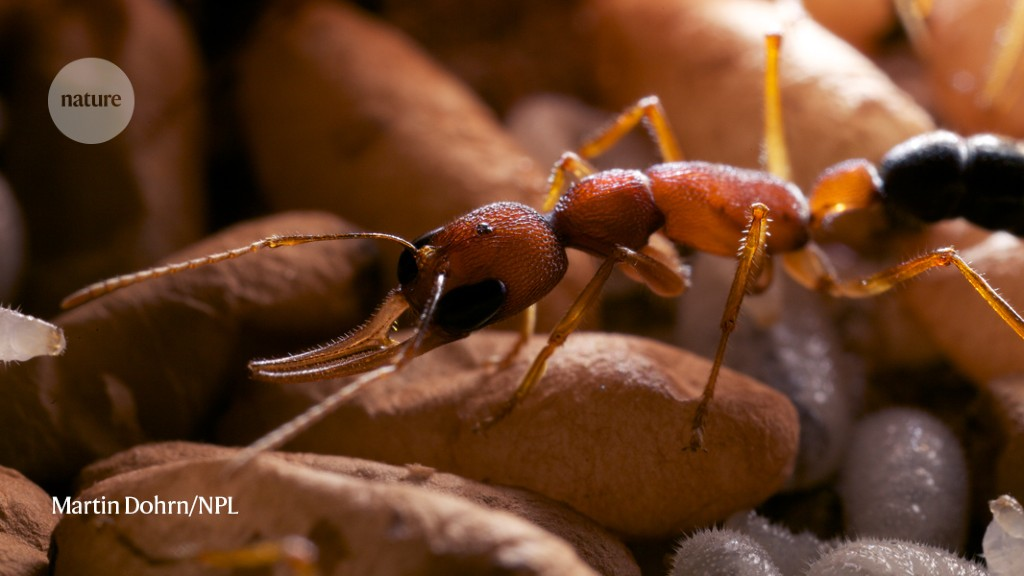How Strong Are Ants Compared to Humans and 10 Fascinating Facts
 |
| How strong are Ants compared to Human? |
Ants are common insects, but they have some unique capabilities. More than 10,000 known ant species occur around the world. They are especially prevalent in tropical forests, where they may be up to half of all the insects living in some locations.
Enthusiastically social insects, ants typically live in structured nest communities that may be located underground, in ground-level mounds, or in trees. Carpenter ants nest in wood and can be destructive to buildings. Some species, such as army ants, defy the norm and do not have permanent homes, instead seeking out food for their enormous colonies during periods of migration.
Ants communicate and cooperate by using chemicals that can alert others to danger or lead them to a promising food source. They typically eat nectar, seeds, fungus, or insects. However, some species have diets that are more unusual. Army ants may prey on reptiles, birds, or even small mammals.
What is the maximum weight a human can lift?
 |
| Photo: Shutterstock |
Some sports experts believe weightlifters have reached a saturation point but the imminent question remains - what is the maximum weight a human could ever lift.
Brit strongman Andy Bolton set the heaviest dead lift record when he lifted 457.5 kilograms from the floor to his thigh. The record for an overhead lift stands at 263.5 kilograms.
According to Dan Wathen, an athletics trainer at Youngstown State University, Ohio, Bolton and weightlifters like him are nearly five or six times stronger than the average man, who will struggle to lift 45 kilograms over his head, reports the New Scientist.
Todd Schroeder at the University of Southern California in Los Angeles, says, “If you look over time at the records for maximal lifts, they have crept up but are starting to plateau.”
“Today’s weightlifters, including those that use steroids, are near the limit of human potential.” Todd Schroeder added. It is the muscles that set the limit. Most failures to lift a given amount do not damage the body, the weightlifter simply cannot overcome a load. But in cases where something does give way, it is usually the muscle fibres that tear, often near the tendon.
Similarly, it is control of the muscles that gives weightlifters their advantage. The body has natural inhibitory mechanisms designed to keep us from hurting ourselves by trying to lift too much. These work by controlling how many muscle fibres are activated at any one time. Weightlifters learn to suppress these signals, enabling them to use a larger fraction of the muscle’s potential in lifting.
Beyond that, the key to success is training, though genetics plays a role. Short limbs favour strength, says Wathen, a former weightlifter, and some people have more muscle fibres than others.
Are Ants Stronger Than Humans and if so Then How Are They So Strong?
 |
| manbeastextraordinaire via flickr |
The most weight a human has ever been able to dead-lift above their head was 580 pounds. The maximum weight a human has lifted to their waist-level is 1008 pounds. Most humans would struggle to lift even 99 pounds above their head, however, and meanwhile, ants shrug at such a task, with some species easily able to lift 5,000 times their weight and carry 1,000 times their weight with little difficulty.
How Much Can an Ant Lift?
 |
| Photo: Martin Dohrn |
In actual numbers, one simply needs to do some math to determine what exactly an ant is capable of lifting in actual numbers. Assuming the average ant weights up to about 5mg and can theoretically lift 5000 times its weight, that would mean an individual ant could pick-up 25,000mg or .055 pounds.
To help put these numbers in perspective it can be helpful to think of pill sizes. Consider a daily vitamin and how a decent-sized one that is still possible to swallow is about 1,000 mg. Go ahead multiply that pill by 25 and you’ve got approximately the weight an ant can theoretically lift. It goes without saying that would be quite a pill!
Now, it was discussed how ants can maybe pick-up 5,000 times their body-weight but moving it around is difficult, with 1,000 times their weight being easier to actually move around with. This means an ant could easily carry about 5,000 mg without too much trouble, a still sizable theoretical pill you’d have to cut-up a number of times to have any chance of swallowing!
Plus, we are talking about a single ant here, when one imagines a group of ants sharing the load of some heavy weight that makes it easy to picture why sometimes a large group of ants has been spotted carrying together something as hefty as a dead bird, rat, or other quite-large meal.
Ants Are Even Stronger Than You Imagine: The Scientific Explanation
New research showed that the neck joint of a common field ant can withstand 5,000 times the ant’s weight. Previously, ants had been photographed carrying dead baby birds, so it was estimated they could carry around 1,000 times their weight. But the new numbers surprised even the researchers.
“We guessed that the ants could withstand about 1,000 times their weight, so we figured we’d start there,” said Carlos Castro, a mechanical and aerospace engineer at The Ohio State University in Columbus. “Initially we didn’t think this ant had any extreme capabilities, but they surprised us.”
Testing the ants' strength involved extreme and destructive measures.
Castro and his colleagues anesthetized common field ants and glued their heads to a centrifuge about the size of a compact disc. As the disc spun faster and faster, the forces applied to the ants increased – until their necks deformed, and their heads separated from their bodies at the tiny neck joint.
“We had to put a Plexiglas barrier around the centrifuge to protect the grad students,” said Castro, “because the ant bodies would go flying at the moment of rupture.” The ants’ necks ruptured when the centrifuge applied forces of 3,400 to 5,000 times their average body weight.
In addition to the centrifugal studies, Castro used microcomputed tomography to reconstruct a 3-D model of the ant’s neck joint.
He found that the surface of the ant’s neck had a microstructure of bumps and folds that helped the ants shoulder large loads.
“From a materials standpoint, we found that the properties themselves are similar to other insects,” said Castro. “We think it’s this design rather than material design that helps the ants.”
Thomas Endlein, a researcher at the University of Glasgow who has studied the sticky pads on ants’ feet, added that lifting large weights is problematic for several reasons -- including the muscle strength, the structural stiffness and balance.
“Muscle strength is often not a problem as smaller animals have relatively more muscle strength to their body weight compared to larger animals,” he wrote in an email to Inside Science. “Still, balancing the weights is a big problem. First, ants have to lever off the weights from the ground which is a tricky business if items are oddly shaped or heavy…then, balancing the item overhead when walking, [it] is also very tricky to avoid falling over.”
Mike Kaspari, a biologist at the University of Oklahoma, said that microbotics – the blending of biology and engineering to build tiny semi-smart animatrons – is one of the most exciting new technologies. “The hope is that these cheap microbots can explore, monitor, and fix our environment, as well as perform other tasks through sheer force of numbers,” he said. “This is another lovely example of how engineers look to the ant to inspire their designs.”
10 Fascinating Facts About Ants
1. Ants Have Super-Human Strength
Ants can carry objects 50 times their own body weight in their jaws. Relative to their size, their muscles are thicker than those of larger animals—even humans. This ratio enables them to produce more force and carry larger objects. If you had muscles in the proportions of ants, you'd be able to heave a Hyundai over your head.
2. Soldier Ants Use their Heads to Plug Holes
In certain ant species, the soldier ants have modified heads, shaped to match the nest entrance. They block access to the nest by sitting just inside the entrance, with their heads functioning like a cork in a bottle to keep intruders at bay. When a worker ant returns to the nest, it touches the soldier ant's head to let the guard know it belongs to the colony.
3. Ants Can Form Symbiotic Relationship with Plants
Ant plants, or myrmecophytes, are plants that have naturally occurring hollows in which ants can take shelter or feed. These cavities may be hollow thorns, stems, or even leaf petioles. The ants live in the hollows, feeding on sugary plant secretions or the excretions of sap-sucking insects. What does a plant get for providing such luxurious accommodations? The ants defend the host plant from herbivorous mammals and insects and may even prune away parasitic plants that attempt to grow on it.
4. The Total Biomass of Ants = The Biomass of People
How can this be? After all, ants are so tiny, and we're so much bigger. That said, scientists estimate there are at least 1.5 million ants on the planet for every human being. Over 12,000 species of ants are known to exist, on every continent except Antarctica. Most live in tropical regions. A single acre of Amazon rainforest may be home to 3.5 million ants.
5. Ants Sometimes Herd Insects of Other Species
Ants will do just about anything to get the sugary secretions of sap-sucking insects, such as aphids or leafhoppers. To keep the honeydew in close supply, some ants herd aphids, carrying the soft-bodied pests from plant to plant. Leafhoppers sometimes take advantage of this nurturing tendency in ants and leave their young to be raised by the ants. This allows the leafhoppers to raise another brood.
6. Some Ants Enslave Other Ants
Quite a few ant species take captives from other ant species, forcing them to do chores for their own colony. Honeypot ants even enslave ants of the same species, taking individuals from foreign colonies to do their bidding. Polyergus queens, also known as Amazon ants, raid the colonies of unsuspecting Formica ants. The Amazon queen finds and kills the Formica queen, then enslaves the Formica workers. The enslaved workers help the usurping queen rear her own brood. When her Polyergus offspring reach adulthood, their sole purpose is to raid other Formica colonies and bring back their pupae, ensuring a steady supply of enslaved workers.
7. Ants Lived Alongside Dinosaurs
Ants evolved some 130 million years ago during the early Cretaceous period. Most fossil evidence of insects is found in lumps of ancient amber, or fossilized plant resin. The oldest known ant fossil, a primitive and now extinct ant species named Sphercomyrma freyi, was found in Cliffwood Beach, New Jersey. Though that fossil only dates back 92 million years, another fossil ant that proved nearly as old has a clear lineage to present-day ants, which suggests a much longer evolutionary line than previously assumed.
8. Ants Started Farming Long Before Humans
Fungus-farming ants began their agricultural ventures about 50 million years before humans thought to raise their own crops. The earliest evidence suggests ants began farming as early as 70 million years ago, in the early Tertiary period. Even more amazing, these ants used sophisticated horticultural techniques to enhance their crop yields, including secreting chemicals with antibiotic properties to inhibit mold growth and devising fertilization protocols using manure.
9. Ant 'Supercolonies' Can Stretch Thousands of Miles
Argentine ants, native to South America, now inhabit every continent except Antarctica due to accidental introductions. Each ant colony has a distinctive chemical profile that enables members of the group to recognize one another and alerts the colony to the presence of strangers. Scientists recently discovered that massive supercolonies in Europe, North America, and Japan all share the same chemical profile, meaning they are, in essence, a global supercolony of ants.
10. Scout Ants Lay Scent Trails to Guide Others to Food
By following pheromone trails laid by scout ants from their colony, foraging ants can gather and store food efficiently. A scout ant first leaves the nest in search of food, wandering somewhat randomly until it discovers something edible. It then consumes some of the food and returns to the nest in a direct line. It seems scout ants can observe and recall visual cues that enable them to navigate quickly back to the nest. Along the return route, the scout ants leave a trail of pheromones—which are special scents they secrete—that guide their nestmates to the food. The foraging ants then follow the path designated by the scout ant, each one adding more scent to the trail to reinforce it for others. Worker ants continue walking back and forth along the trail until the food source is depleted.
What are the Strongest Species of Ants?Leafcutter ant (thera are 47 species; wtf) carring a stone 10 times bigger then its head – Tyrona Nationalpark, Colombia; PanAmericana 2017 – the image was taken on an overlanding travel from Ushuaia to Anchorage – taken by Thomas Fuhrmann, SnowmanStudios – see more pictures on / mehr Aufnahmen auf www.snowmanstudios.de In terms of relative strength when the question arises which species of ant is the strongest, the answer you’ll hear is, “The Leafcutter ant, without a doubt.” Between how well they work together (such as carrying a dead animal like the mentioned birds and mice) and how much strength a single one has, the Leaftcutter ant is the kind to think of when considering ants that can carry 1,000 times their weight and lift 5,000 times their weight. Some species can come close to these numbers as well, but the Leafcutter ant is the champ. |
 How to Change Email Address on Facebook With Easy Steps How to Change Email Address on Facebook With Easy Steps Facebook allows you to maximize experience including changing your primary email address. If you haven't known how to change, don't miss this article. |
 How To Change Your Location and Local Stations In YouTube TV How To Change Your Location and Local Stations In YouTube TV There are many ways to change your location and local stations in Youtube TV. Follow our simple guides! |
 Amazing Facts About Thunderstorms: Causes, Types and How to Stay Safe Amazing Facts About Thunderstorms: Causes, Types and How to Stay Safe Whether you enjoy stormy weather or not, thunderstorms happen anyway. But how much do you really know about thunderstorms? |
 What are the Caribbean Countries? What are the Caribbean Countries? Do you know how many countries are there in Caribbean? And what are they? Keep reading the article below to find out. |


























